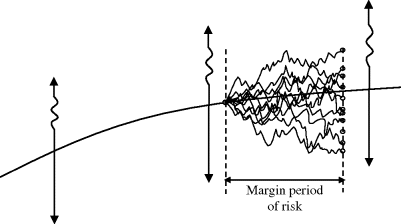9.7 Exposure and Collateral
Uncollateralised credit exposure should be considered over the full time-horizon of the transaction or transactions in question. Long-term distributional assumptions, such as mean-reversion and drift, are important and the specifics of the transactions, such as cash flow dates and exercise times, must be considered. Collateral changes the above picture by transforming a risk that should be considered usually over many years into one that need only be considered over a much shorter period (the margin period of risk). This is illustrated in Figure 9.19, which shows some future point where a position is well collateralised (e.g., no threshold in the CSA) and hence the main concern is the relatively small amount of risk over the margin period of risk (for example, the cash flows shown in Figure 9.19 are not as important due to the length of the margin period of risk). Hence, some of the intricacies of modelling potential future exposure can hopefully be ignored as long as the counterparty is well collateralised. The problem now becomes a short-term market risk issue and therefore shares many commonalities with market risk VAR methodologies.
Figure 9.19 Schematic illustration of the impact of collateralisation on potential future exposure.

Whilst the above may seem plausible, we will see that the overall impact of collateral is not always straightforward ...
Get Counterparty Credit Risk and Credit Value Adjustment: A Continuing Challenge for Global Financial Markets, 2nd Edition now with the O’Reilly learning platform.
O’Reilly members experience books, live events, courses curated by job role, and more from O’Reilly and nearly 200 top publishers.

